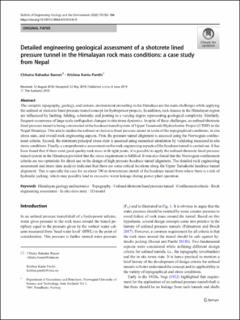| dc.contributor.author | Basnet, Chhatra Bahadur | |
| dc.contributor.author | Panthi, Krishna Kanta | |
| dc.date.accessioned | 2020-04-03T08:51:22Z | |
| dc.date.available | 2020-04-03T08:51:22Z | |
| dc.date.created | 2019-07-10T10:48:08Z | |
| dc.date.issued | 2020 | |
| dc.identifier.citation | Bulletin of Engineering Geology and the Environment. 2020, 79 (Issue 1), 153-184. | en_US |
| dc.identifier.issn | 1435-9529 | |
| dc.identifier.uri | https://hdl.handle.net/11250/2650224 | |
| dc.description.abstract | The complex topography, geology, and tectonicenvironment prevailingin the Himalaya are the mainchallengeswhile applying theunlinedorshotcretelinedpressuretunnelconcept for hydropowerprojects.Inaddition,rockmassesintheHimalayanregion are influenced by faulting, folding, schistosity, and jointing to a varying degree representing geological complexity. Similarly, frequent occurrence of large scale earthquakes changes in situ stress dynamics. In spite of these challenges, an unlined/shotcrete lined pressure tunnel is beingconstructed at the headrace tunnel system of Upper Tamakoshi Hydroelectric Project(UTHP) in the Nepal Himalaya. This article studies the unlined or shotcrete lined pressure tunnel in terms of the topographical conditions, insitu stress state, and overall rock engineering aspects. First, the pressure tunnel alignment is assessed using the Norwegian confinement criteria. Second, the minimum principal stress state is assessed using numerical simulation by validating measured in situ stress conditions. Finally, acomprehensive assessment on the rock engineering aspects of the headrace tunnel is carriedout. It has been found that if there exist good quality rock mass with tight joints, it is possible to apply the unlined/shotcrete lined pressure tunnel system in the Himalaya provided that the stress requirement is fulfilled. It was also found that the Norwegian confinement criteria are too optimistic for direct use in the design of high pressure headrace tunnel alignment. The detailed rock engineering assessment and stress state analysis indicated that there are some critical locations along the Upper Tamakoshi headrace tunnel alignment. This is specially the case for an about 700 m downstream stretch of the headrace tunnel from where there is a risk of hydraulic jacking, which may possibly lead to excessive water leakage during power plant operation. | en_US |
| dc.language.iso | eng | en_US |
| dc.publisher | Springer Verlag | en_US |
| dc.rights | Navngivelse 4.0 Internasjonal | * |
| dc.rights.uri | http://creativecommons.org/licenses/by/4.0/deed.no | * |
| dc.title | Detailed engineering geological assessment of a shotcrete lined pressure tunnel in the Himalayan rock mass conditions: a case study from Nepal | en_US |
| dc.type | Peer reviewed | en_US |
| dc.type | Journal article | en_US |
| dc.description.version | publishedVersion | en_US |
| dc.source.pagenumber | 153-184 | en_US |
| dc.source.volume | 79 | en_US |
| dc.source.journal | Bulletin of Engineering Geology and the Environment | en_US |
| dc.source.issue | Issue 1 | en_US |
| dc.identifier.doi | 10.1007/s10064-019-01544-9 | |
| dc.identifier.cristin | 1711018 | |
| dc.relation.project | Norges forskningsråd: 257588 | en_US |
| dc.description.localcode | Open Access This article is distributed under the terms of the Creative Commons Attribution 4.0 International License (http://creativecommons.org/licenses/by/4.0/), which permits unrestricted use, distribution, and reproduction in any medium, provided you give appropriate credit to the original author(s) and the source, provide a link to the Creative Commons license, and indicate if changes were made. | en_US |
| cristin.ispublished | true | |
| cristin.fulltext | original | |
| cristin.qualitycode | 2 | |

